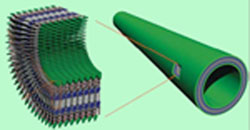| Posted: December 14, 2006 |
Nanotube photoconductors |
|
(Nanowerk News) Japanese researchers report the construction of a molecule that self-assembles into nano-sized tubes which generate a current when irradiated. The nanotubes could serve as building blocks for future nanoscale photovoltaics, electronics, and photo-detectors.
|
|
In previous work, Takuzo Aida and colleagues at the University of Tokyo, Japan, showed that an amphiphilic hexa-peri-hexabenzocoronene (HBC) molecule self-assembles into nanotubes in tetrahydrofuran. When oxidized, the tubes showed electrical conductivity similar to that of inorganic semiconductor tubes ("Self-Assembled Hexa-peri-hexabenzocoronene Graphitic Nanotube").
|
 |
| A molecular layer of electron-accepting TNF (green) laminates an electron-donating graphitic layer of p-stacked HBC (blue). (Image: Science)
|
|
By adding trinitrofluorenone (TNF) to HBC, Aida’s team has now found that the nanotubes self-assemble and conduct an electrical current when irradiated (Y Yamamoto et al, Science, 2006, 314, 1761 - not published yet).
|
|
‘Our nanotube adopts a coaxial donor–acceptor configuration where a molecular layer of electron-accepting TNF laminates an electron-donating graphitic layer of p-stacked HBC,’ Aida told Chemistry World. ‘This architecture enables photoconduction, characterized by a large on/off ratio where the electrical current realized under light is 10 000 times greater than that in the dark,’ he said. ‘Such a large on/off ratio is essential for optoelectronic applications.’
|
|
To trigger self-assembly of the nanotubes, which are 16 nanometres in diameter and several micrometres long, the researchers exposed a tetrahydrofuran solution of HBC–TNF to a methanol vapour. When the concentration of HBC–TNF in solution was higher than 1.2mM, non-conductive microfibers formed. When the concentration of the molecule was less than 0.12mM, however, photoconductive coaxial nanotubes self-assembled.
|
|
‘These nanotubes are really of very high order and they seem to be pretty robust,’ Frank Würthner, a supramolecular chemist at the University of Würzburg, Germany, told Chemistry World. ‘They make a very promising field of research,’ he said.
|
|
Researchers working in the emerging field of supramolecular electronics aim to use organic nano-objects with well-defined electronic functions as components in, for example, light-emitting diodes, transistors, and photovoltaic cells. These organic devices are expected to be more efficient, lightweight, and have a good cost performance compared with conventional silicon-based electronics, said Aida.
|
|
‘The key fabrication process to achieve supramolecular electronics consists of bottom-up nanotechnology based on self-assembly of functional molecular building blocks,’ explained Aida. ‘Our nanotube provides an ultimate molecular design strategy to achieve a donor–acceptor heterojunction with an extraordinarily wide interface, which is really needed for photoconductive and photovoltaic materials.’
|
|
However, said Würthner, ‘such structures are not yet easy to integrate into currently available technologies.’
|

